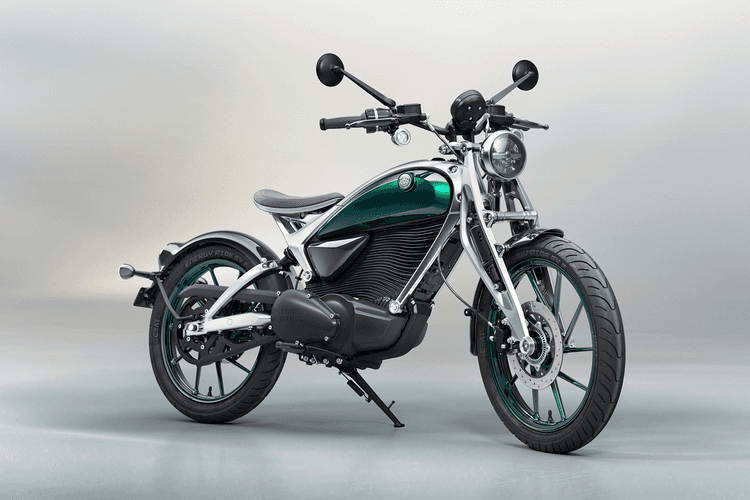
Royal Enfield, a name synonymous with timeless design and rugged reliability, has made a historic move into the future of transportation with the announcement of its first-ever electric motorcycle, the Flying Flea. Known as the world’s oldest motorcycle brand in continuous production, Royal Enfield has maintained its reputation for crafting iconic bikes that combine heritage and innovation. Now, with this groundbreaking project, the company is entering the electric era, blending its legendary DNA with cutting-edge technology.
The Flying Flea—a nod to a model used by paratroopers during World War II—will be powered by Qualcomm’s advanced Car-to-Cloud platform, featuring a brand-new Snapdragon chip designed specifically for this motorcycle. This marks a bold step for Royal Enfield, signaling its commitment to evolving with the times while staying true to its storied legacy.
A Legacy Reinvented: Why the Flying Flea?
Royal Enfield’s history is steeped in tradition, with its bikes being symbols of adventure, resilience, and style. The decision to revive the Flying Flea name for its first electric model is significant. The original Flying Flea, a lightweight 125cc motorcycle, was famously used during World War II for military operations. It was small enough to be dropped by parachute, and its versatility made it an invaluable asset in challenging terrains.
By naming its first electric bike after this iconic model, Royal Enfield emphasizes the continuation of its adventurous spirit, even in a completely new category. The new Flying Flea represents freedom, innovation, and adaptability, just as its predecessor did nearly eight decades ago.
Powered by Qualcomm’s Car-to-Cloud Platform
At the heart of the Flying Flea is Qualcomm’s Car-to-Cloud platform, which adds a layer of intelligence and connectivity that is groundbreaking for motorcycles. This platform integrates advanced telematics, cloud-based data analysis, and over-the-air updates, ensuring the bike stays updated with the latest software enhancements.
To power this platform, Qualcomm has developed a new Snapdragon chip specifically designed for the Flying Flea. This chip is engineered to handle multiple functions, from optimizing battery performance to enabling real-time data communication and navigation systems. The result is a bike that not only performs exceptionally on the road but also keeps riders connected to the digital ecosystem.
According to Qualcomm, the Snapdragon chip will help the Flying Flea achieve efficient power management, extended battery life, and enhanced rider safety through predictive analytics and real-time diagnostics. Riders will have access to smart features like navigation, ride stats, and personalized updates via a dedicated app.
Sustainability Meets Performance
Royal Enfield’s move into electric motorcycles is driven by a commitment to sustainability without compromising the performance and thrill that riders have come to expect from the brand. The Flying Flea is designed to deliver a smooth, quiet ride while still retaining the torque and power characteristic of Royal Enfield’s gas-powered models.
While detailed specifications of the bike’s motor and battery capacity have yet to be announced, Royal Enfield has hinted at a robust electric drivetrain capable of handling long-distance journeys and urban commutes alike. The company is also prioritizing fast-charging technology, ensuring that the Flying Flea is as convenient as it is eco-friendly.
The design of the Flying Flea stays true to Royal Enfield’s aesthetic principles. Early images suggest a minimalist, retro-inspired look with modern accents—a nod to the brand’s heritage while embracing the future. Features like a lightweight frame, ergonomic seating, and LED lighting will ensure the bike is both stylish and practical.
The Role of Qualcomm’s Snapdragon Chip
One of the most exciting aspects of the Flying Flea is its debut of Qualcomm’s new Snapdragon chip, tailored specifically for electric motorcycles. This chip offers an unprecedented level of integration, handling everything from motor efficiency to connected features. Key capabilities of the Snapdragon chip include:
Smart Power Management: The chip monitors battery performance and adjusts power delivery for optimal efficiency, ensuring the bike has an impressive range per charge.
Real-Time Connectivity: Riders can access critical information, including charging station locations, route optimization, and traffic updates, directly through the bike’s dashboard or a paired smartphone app.
Predictive Maintenance: The chip analyzes data from the bike’s sensors to alert riders about potential maintenance needs, reducing downtime and improving safety.
Customizable Riding Modes: Thanks to the chip’s processing power, the Flying Flea will offer multiple riding modes, allowing riders to switch between performance, economy, and urban settings seamlessly.
The collaboration with Qualcomm not only underscores Royal Enfield’s dedication to adopting the latest technology but also positions the Flying Flea as a serious contender in the burgeoning electric motorcycle market.
Bringing Heritage to the Electric Age
Royal Enfield’s electric journey is not just about adopting new technology but also about staying true to its roots. The company has always been known for its storytelling, and the Flying Flea is no exception. The bike’s design reflects the classic Royal Enfield ethos, with a focus on craftsmanship, durability, and timeless appeal.
The transition to electric bikes comes at a time when global demand for sustainable transportation is surging. Governments around the world are encouraging the adoption of electric vehicles, and the motorcycle industry is no exception. By entering the electric segment, Royal Enfield aims to appeal to environmentally conscious riders while continuing to deliver the emotional and tactile connection that defines its brand.
Challenges and Opportunities
While the move to electric motorcycles is a significant opportunity, it also presents challenges. Royal Enfield will need to ensure that the Flying Flea meets the high expectations of its loyal customer base while attracting a new generation of riders. Key considerations include:
•Range and Charging Infrastructure: Ensuring the bike offers competitive range and convenient charging options will be crucial.
•Preserving the Riding Experience: Many Royal Enfield fans value the sound and feel of a traditional engine. Striking a balance between nostalgia and modernity will be critical.
•Global Rollout: Expanding production and distribution to meet the demand for electric motorcycles in different regions will require strategic planning.
Despite these challenges, the Flying Flea has the potential to become a game-changer, not only for Royal Enfield but for the electric motorcycle industry as a whole.
Looking Ahead
Royal Enfield’s announcement of the Flying Flea marks a pivotal moment in the brand’s 122-year history. By combining its legendary craftsmanship with Qualcomm’s state-of-the-art technology, the company is positioning itself as a leader in the electric mobility revolution.
With its blend of heritage, innovation, and sustainability, the Flying Flea is more than just a motorcycle—it’s a statement of Royal Enfield’s ability to adapt and thrive in an evolving industry. As the world moves toward a greener future, Royal Enfield is proving that even the most traditional brands can embrace change without losing their essence.
The Flying Flea is set to redefine what it means to ride a Royal Enfield, offering a thrilling, eco-friendly experience that honors the past while looking boldly toward the future. As the world eagerly awaits its launch, one thing is certain: the Flying Flea is not just a bike—it’s the beginning of a new chapter in Royal Enfield’s remarkable journey.
No comments yet.







